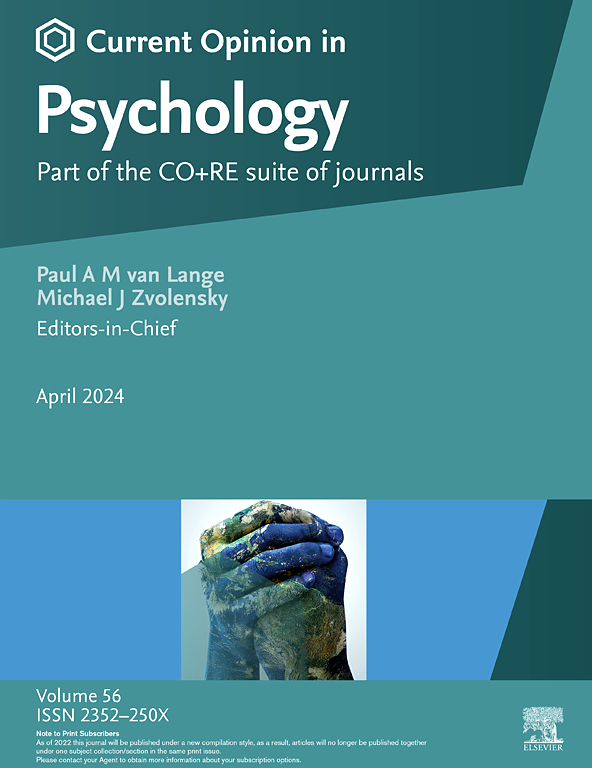The altruistic personality: Insights from research with extraordinary altruists
IF 6.9
2区 心理学
Q1 PSYCHOLOGY, MULTIDISCIPLINARY
引用次数: 0
Abstract
Humans possess a remarkable capacity for altruism, frequently providing help to a wide range of beneficiaries, including strangers. But people also vary in their tendency to behave altruistically. A small subset of people engages in extraordinary altruism: rare, costly, non-normative acts such as non-directed organ or marrow donation, heroic rescues, and humanitarian aid work. These extraordinary altruists may be a uniquely valuable population for identifying traits that underlie altruism. This is because extraordinary altruism typically occurs in contexts that offer few potential self-benefits and have weak or absent social norms, helping isolate dispositional from situational influences. Recent research with extraordinary altruists suggests individual variation in altruism reflects stable differences in how much people value others' welfare relative to their own welfare. Measures that most reliably distinguish extraordinary altruists from controls include the social discounting task and the honesty–humility scale of the HEXACO personality inventory, both of which capture differences in the subjective value of one's own versus other's outcomes. Extraordinary altruists are not distinguished by trait agreeableness or self-reported empathy. However, neuroimaging and behavioral studies find that extraordinary altruists display heightened empathic accuracy and heightened empathic neural responding to others' distress in brain regions implicated in prosocial decision-making. Improved understanding of the traits that distinguish highly altruistic people can offer new insights regarding how to cultivate altruism on a broader scale, for example, through interventions that foster stable increases in how much people value others' welfare.
利他主义人格:来自对非凡利他主义者研究的见解
人类具有非凡的利他主义能力,经常向各种受益人提供帮助,包括陌生人。但人们的利他行为倾向也各不相同。一小部分人从事非凡的利他主义:罕见的,昂贵的,非规范的行为,如非定向的器官或骨髓捐赠,英勇的救援和人道主义援助工作。这些非凡的利他主义者可能是一个独特的有价值的群体,可以识别出利他主义背后的特征。这是因为非凡的利他行为通常发生在提供很少潜在自我利益的环境中,并且社会规范薄弱或缺失,有助于将性格与情境影响隔离开来。最近对非凡利他主义者的研究表明,利他主义的个体差异反映了人们对他人福利相对于自己福利的重视程度的稳定差异。最可靠的区分非凡利他主义者和控制组的方法包括社会折扣任务和HEXACO人格清单中的诚实-谦卑量表,这两种方法都捕捉到了一个人对自己和他人结果的主观价值的差异。非凡的利他主义者并不以性格亲和性或自我报告的同理心来区分。然而,神经影像学和行为研究发现,非凡的利他主义者在涉及亲社会决策的大脑区域表现出更高的共情准确性和对他人痛苦的共情神经反应。对高度利他主义的人的特征的更好理解可以为如何在更大范围内培养利他主义提供新的见解,例如,通过干预促进人们对他人福利的重视程度的稳定增长。
本文章由计算机程序翻译,如有差异,请以英文原文为准。
求助全文
约1分钟内获得全文
求助全文
来源期刊

Current Opinion in Psychology
PSYCHOLOGY, MULTIDISCIPLINARY-
CiteScore
12.10
自引率
3.40%
发文量
293
审稿时长
53 days
期刊介绍:
Current Opinion in Psychology is part of the Current Opinion and Research (CO+RE) suite of journals and is a companion to the primary research, open access journal, Current Research in Ecological and Social Psychology. CO+RE journals leverage the Current Opinion legacy of editorial excellence, high-impact, and global reach to ensure they are a widely-read resource that is integral to scientists' workflows.
Current Opinion in Psychology is divided into themed sections, some of which may be reviewed on an annual basis if appropriate. The amount of space devoted to each section is related to its importance. The topics covered will include:
* Biological psychology
* Clinical psychology
* Cognitive psychology
* Community psychology
* Comparative psychology
* Developmental psychology
* Educational psychology
* Environmental psychology
* Evolutionary psychology
* Health psychology
* Neuropsychology
* Personality psychology
* Social psychology
 求助内容:
求助内容: 应助结果提醒方式:
应助结果提醒方式:


